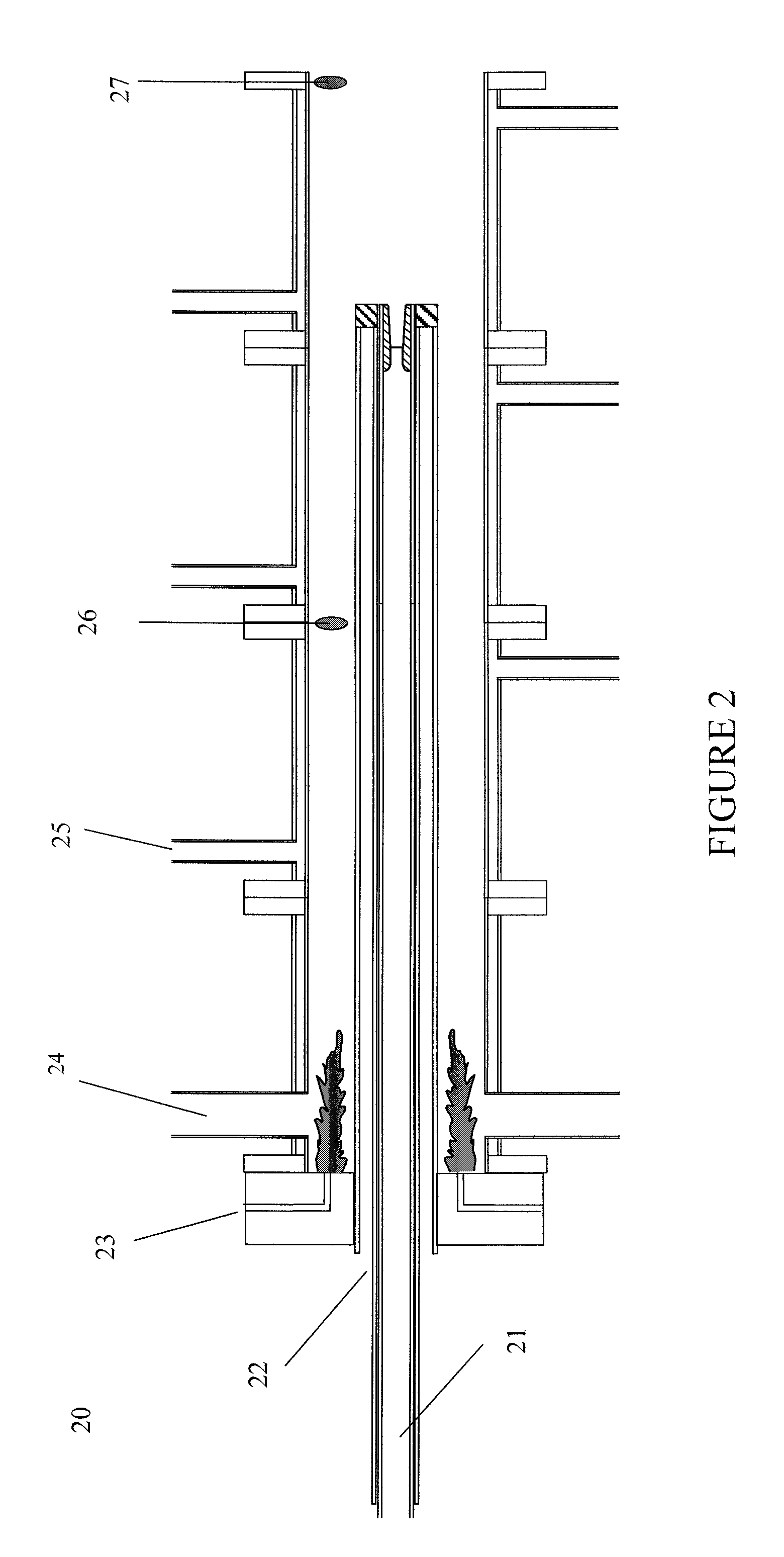Injection method for inert gas
a technology of inert gas and injection method, which is applied in the direction of charge manipulation, combustion types, furnaces, etc., can solve the problems of ineffective internal shroud method for producing coherent jets of inert gases, oxidation of steel and undesirable by-products, and affecting the quality of steel, so as to reduce the supply pressure, enhance the beneficial stirring action of the melt, and reduce the effect of the stirring action
- Summary
- Abstract
- Description
- Claims
- Application Information
AI Technical Summary
Benefits of technology
Problems solved by technology
Method used
Image
Examples
example 1
Argon Coherent Jets with Fuel
[0062]Experiments were conducted to try to produce a pure argon coherent jet injecting only internal shroud fuel. The internal shroud inert gas coherent jet injector used is illustrated in FIGS. 1(a) and 1(b). FIG. 1(a) is a view of the outlet of the injector (10) having eight ports (11), equally spaced. These ports are drilled holes and are each approximately 1 / 16 inch in diameter. FIG. 1(b) is a side cutaway view of the injector (10), showing a converging-diverging passageway (12) for the inert gas and passageways (13) that can be used for fuel or a mixture of fuel and oxygen.
[0063]The argon was injected at 100 psig and 3795 scfh and the fuel was natural gas (NG). The nozzle exit (D) and throat (T) diameters were 0.38-in. and 0.26-in., respectively. In a simulated furnace gas, the internal injection of fuel resulted in no change in jet length, as shown in Table 1.
[0064]
TABLE 1Argon With Internal Injection of FuelP.H.P.H.COInj.T.C.T.C.JetO2COFlowNGExitM...
example 2
Argon Coherent Jets with Oxygen and Fuel
[0067]In this set of experiments, the same injector design as in Example 1 was used and both oxygen and fuel were pre-mixed and injected via the passageways 13 into the internal shroud ports to try to produce a coherent argon jet. However, injecting only internal oxygen (up to 2% relative to the argon flow) and injecting both fuel (0.66%) and oxygen (0.97%) resulted in no changes in jet length (i.e., L / Lo=.about.1 for all experiments), as shown in Table 2.
[0068]
TABLE 2Argon With Internal Injection of Oxygen and FuelP.H.P.H.COInj.T.C.T.C.JetO2COFlowInj. NGO2ExitMidLength% NG / % O2 / (scfh)(scfh)(scfh)(scfh)(scfh)(° F.)(° F.)(in.)MAINMAINL / Lo116466051310.000.00189618129.880.000.001.00116466051310.0037.90NTNT10.000.001.001.01116466051310.0071.401868182410.000.001.881.011164660513180.600.00NTNT10.000.780.001.0111646605131103.1036.80NTNT10.000.660.971.01P.H. O2 = Preheat burner O2P.H. CO = Preheat burner COInj. NG = Injection of natural gasT.C. Exit =...
example 3
Injector with Porous Metal Distributor
[0069]Further experiments were run using the injector shown in FIG. 3. This injector (30) used a single porous metal (31), typically brass or bronze or copper, but any metal can be used, to evenly distribute a “pre-mixed” mixture of fuel and oxygen as the internal shroud gas into argon / oxygen main jets of varying compositions, including pure argon. The injector (30) comprises a converging / diverging passageway for the inert gas (32) and additional passageways (33) for fuel and oxygen to form the internal shroud. These experiments were conducted as single nozzle experiments and the converging / diverging passageway was designed to allow for oxygen flow at 4000 scfh (100 psig, Mach 2). In the experiments, the argon and oxygen were flowed between 3775-4000 scfh at 100 psig. The temperature at which the experiments were run was approximately 2250° F. (not corrected for radiation losses).
[0070]FIG. 4 is a graphical representation of the normalized jet l...
PUM
 Login to View More
Login to View More Abstract
Description
Claims
Application Information
 Login to View More
Login to View More - R&D
- Intellectual Property
- Life Sciences
- Materials
- Tech Scout
- Unparalleled Data Quality
- Higher Quality Content
- 60% Fewer Hallucinations
Browse by: Latest US Patents, China's latest patents, Technical Efficacy Thesaurus, Application Domain, Technology Topic, Popular Technical Reports.
© 2025 PatSnap. All rights reserved.Legal|Privacy policy|Modern Slavery Act Transparency Statement|Sitemap|About US| Contact US: help@patsnap.com



